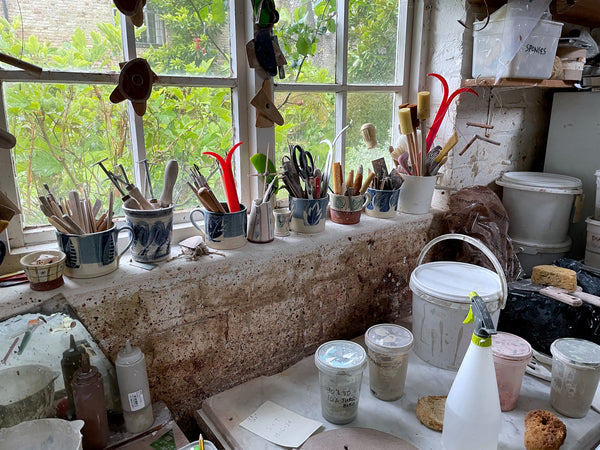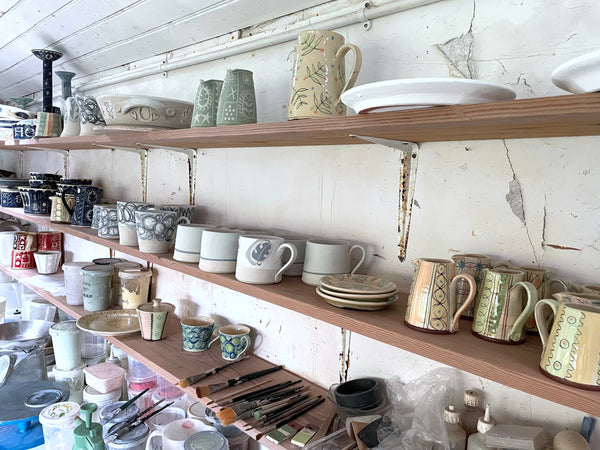
Maker in Focus - Annie Hewett
Annie Hewett began her art training at St. Martins at the end of the sixties, studying graphics. This was followed by several years teaching in secondary schools, and at Stroud College where she was a tutor for painting and drawing and calligraphy.
The change of focus towards working with clay happened when she decided to book herself on to a throwing course so that she would be able to help her younger son with his GCSE ceramics. Annie had always been interested in the subject but had never pursued it. She became completely absorbed!
Annie’s work has been strongly influenced by the illustrative qualities of artists such as Eric Ravilious, Edward Bawden, Stanley Spencer and John Minton as well as textile designers such as Lucienne Day.
We had a chat with Annie to find out more about her ceramic practice.

What inspired you to start making ceramics?
I have always been interested in ceramics from early days in the 1960’s when I spent time hanging around at Winchcombe pottery with friends, (mostly Joe and Trudy Finch). We were always looking at the collection of Michael Cardrew pots and I was mostly interested in the decoration in those days rather than having a desire to make pots myself. Then in the 1970’s I spent time at the Art School in Stroud with my pupils from Stroud High School. The clever ones were allowed to do pottery on a Thursday afternoon and I had to accompany them. Colin Gerard was the tutor and whilst the girls were being taught to throw, I spent my time hand-building, making relief panels depicting Georgian houses. It was only in the 1980’s, when my son was studying ceramics for his ‘A’ levels, that I thought that I should learn to throw myself. I took myself off on a four-day throwing course and was hooked.
You have a few different styles. Which is your favourite?
I use two different clays, a white one for the cobalt and green sgraffito pieces and a red terracotta for the slipware pieces. I don’t really enjoy getting dirty and the red clay is messy so I suppose I should say that the sgraffito pieces are my favourite, but whilst I am in the midst of making the slipware, I love that too! It makes life difficult for me as I need to be very careful cleaning up after using the red clay so that I don’t contaminate the white clay when I change over.
What drew you to sgraffito?
I studied Graphic Design and Illustration at art school and have always been attracted to letterforms and typography. Drawing is key to everything I have done in whatever medium I was working in. I have worked with many, some not traditionally associated with drawing or lettering. The feeling of drawing through a layer of coloured slip to reveal the clay body underneath is sublime, (all supposing that I catch the clay at the perfect point of dryness. Too wet and it’s horrible and too dry it’s like nails scratching a chalkboard).

How do you decide what colours to glaze your pieces?
The cobalt and dark green pieces achieve their colour from the layer of slip. This forms a blank surface onto which I can draw directly onto the pot to create the designs. This slip is made from a mixture of clay and oxides, cobalt, chrome and copper. The paler, pastel ‘Retro’ style pieces are also achieved using slips, these are coloured with a mixture of clay, coloured stains and oxides. This time the red clay pieces are coated in a white slip before painting on the various colours. I tend to limit the palette to 5 or 6 colours but can also mix these to get variations on each piece but the whole collection works together. What most non-potters don’t realise is that what is painted on the pot can be a completely different colour in appearance from when it is fired and then glazed. I often get unfortunate surprises when something finishes up a very different colour from what I intended. It’s usually horrible. Everything is given a transparent glaze for the second firing.
What inspires the designs for your pieces?
As I mentioned, I have always been inspired by letterforms and typography and also am very fond of plants too. The weaving of both these elements together in many different ways is what keeps me making. Just the pleasure that drawing gives me makes it worthwhile.
What is your newest ‘make’?
I have been making some completely plain mugs in a mid-turquoise green. They are a good foil for both the dark green engraved pieces and the ‘retro’ pieces. they give the eye a rest after all the pattern.

What does being part of The Guild mean to you?
The Guild has been a great facilitator for getting makers from all sorts of disciplines together. We are able to share in the business of making (and selling) and commiserate with each other over technical difficulties and enjoy discussing all the different facets of being makers. It has given me the opportunity to get to know members from all the other disciplines and to learn much more about their craft. The Guild shop has opened up greater opportunities, not only to meet up with other members but also to interact with the public, our potential customers.
Do you have any events coming up?
I am taking part in a weekend show with a group of other makers (5 of whom are Guild members) on May 11th and 12th at Frogmarsh Mill between Stroud and Nailsworth.
What is on your ‘wish list’ from The Guild shop?
This is an impossible one to answer, everything, of course!
